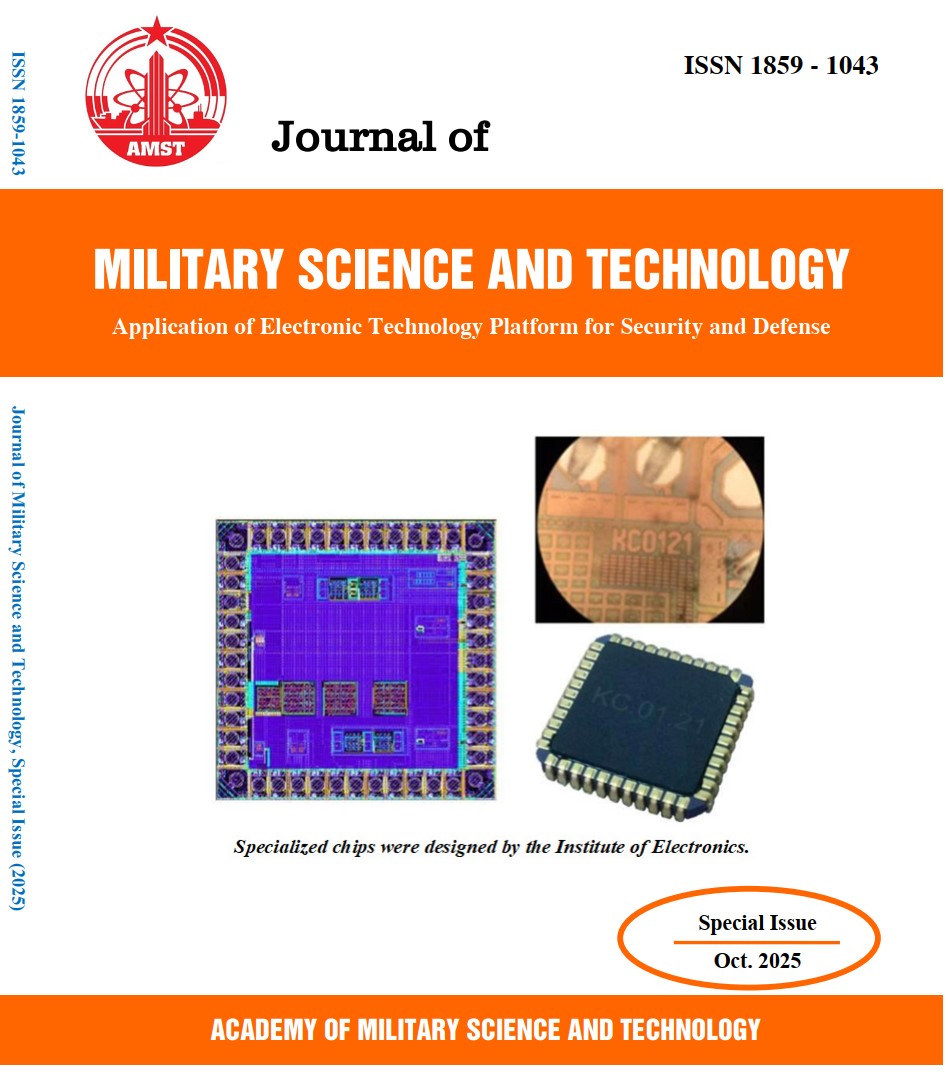Outage probability analysis of RIS-assisted RSMA systems over Nakagami-m fading channels
315 viewsDOI:
https://doi.org/10.54939/1859-1043.j.mst.IITE.2025.72-82Keywords:
Outage probability; Energy efficiency; Rate-splitting multiple access; Reconfigurable intelligent surface; Imperfect successive interference cancellation.Abstract
In this study, we propose and analyze an RIS-assisted rate-splitting multiple access (RSMA) system. The framework enhances transmission efficiency by simultaneously exploiting both the direct and RIS-reflected links to serve two users. For practical considerations, imperfect successive interference cancellation (SIC) is taken into account. Under the Nakagami-m fading channel model, closed-form expressions for the outage probability (OP) and energy efficiency (EE) are derived and verified through Monte Carlo simulations with a large number of iterations. Furthermore, a comprehensive comparative analysis with a benchmark RIS-assisted non-orthogonal multiple access (NOMA) scheme is conducted. Simulation results show that the proposed system significantly outperforms its NOMA counterpart in terms of OP. The impacts of key system parameters, including the number of RIS reflecting elements, transmit power, carrier frequency, fading severity, and SIC imperfection level, are thoroughly investigated. These findings demonstrate the strong potential of RIS-assisted RSMA as a promising solution to enhance the reliability of future sixth-generation (6G) wireless networks.
References
[1]. Liang, J., Chan, T.-T., and Pan, H. "Minimizing age of collection for multiple access in wireless industrial Internet of Things", IEEE Internet of Things Journal, 11(2), 2753–2766, (2024). DOI: https://doi.org/10.1109/JIOT.2023.3293142
[2]. Zhang, Y et al. "Multiple access integrated adaptive finite blocklength for ultra-low delay in 6G wireless networks", IEEE Transactions on Wireless Communications, 23(3), 1670–1683, (2024). DOI: https://doi.org/10.1109/TWC.2023.3290936
[3]. Zheng, G., Wen, M., Wen, J., and Shan, C. "Joint hybrid precoding and rate allocation for RSMA in near-field and far-field massive MIMO communications", IEEE Wireless Communications Letters, 13(4), 1034–1038, (2024). DOI: https://doi.org/10.1109/LWC.2024.3358494
[4]. Aswini, K. et al. "Performance analyses of intelligent reflecting surface aided downlink multi-user rate-splitting multiple access system for 6G applications", Computer Networks, 242, 110271, (2024). DOI: https://doi.org/10.1016/j.comnet.2024.110271
[5]. Huang, C., Zappone, A., Debbah, M., and Yuen, C. "Achievable rate maximization by passive intelligent mirrors", in Proc. IEEE International Conference on Acoustics, Speech and Signal Processing (ICASSP), 3714–3718, (2018). DOI: https://doi.org/10.1109/ICASSP.2018.8461496
[6]. Huang, C., et al. "Reconfigurable intelligent surfaces for energy efficiency in wireless communication", IEEE Transactions on Wireless Communications, 18(8), 4157–4170, (2019). DOI: https://doi.org/10.1109/TWC.2019.2922609
[7]. Yang, Z., et al. "Energy efficient rate-splitting multiple access (RSMA) with reconfigurable intelligent surface", in IEEE International Conference on Communications Workshops, 1–6, (2020). DOI: https://doi.org/10.1109/ICCWorkshops49005.2020.9145189
[8]. Z. Niu et al., “Active RIS assisted rate-splitting multiple access network: Spectral and energy efficiency tradeoff,” IEEE Wireless Commun. Lett., Vol. 12, No. 5, pp. 867–871, (2023). DOI: https://doi.org/10.1109/JSAC.2023.3240718
[9]. Fang, T., et al. "Fully connected reconfigurable intelligent surface aided rate-splitting multiple access for multi-user multi-antenna transmission", arXiv preprint arXiv:2201.07048, (2022). DOI: https://doi.org/10.1109/ICCWorkshops53468.2022.9814551
[10]. Weinberger, K et al. "Synergistic benefits in IRS- and RS-enabled C-RAN with energy-efficient clustering", IEEE Transactions on Wireless Communications, 1–1, (2022). DOI: https://doi.org/10.1109/TWC.2022.3166393
[11]. Bansal, A., Singh, K., and Li, C.-P. "Analysis of hierarchical rate-splitting for intelligent reflecting surfaces-aided downlink multiuser MISO communications", IEEE Open Journal of the Communications Society, 2, 785–798, (2021). DOI: https://doi.org/10.1109/OJCOMS.2021.3070340
[12]. Pham, X.-N., Nguyen, B.-C., Thi, T.-D., Nguyen, V.-V., Minh, B.-V., Kim, T., Nguyen, T.-N., and Le, A.-V. "Enhancing data rate and energy efficiency of NOMA systems using reconfigurable intelligent surfaces for millimeter-wave communications", Digital Signal Processing, 151, 104553, (2024). DOI: https://doi.org/10.1016/j.dsp.2024.104553
[13]. Do, T.-N., Kaddoum, G., Nguyen, T.-L., Da Costa, D.-B., and Haas, Z. J. "Multi-RIS-aided wireless systems: Statistical characterization and performance analysis", IEEE Transactions on Communications, 69(12), 8641–8658, (2021). DOI: https://doi.org/10.1109/TCOMM.2021.3117599
[14]. Van, Q.-N., Nguyen, B.-C., Hoang, T.-M., Nguyen, H.-M., Nguyen, V.-V., Luu, G.-T., et al. "Multiple RISs for enhancing the secrecy performance of NOMA systems over realistic Nakagami-m fading channels", IEEE Transactions on Vehicular Technology, 73(5), 6584–6599, (2023). DOI: https://doi.org/10.1109/TVT.2023.3338490
[15]. Jeffrey, A., and Zwillinger, D. "Table of integrals, series, and products", Academic Press, (1994).
[16]. Singh, S.-K., Agrawal, K., Singh, K., and Li, C.-P. "Outage probability and throughput analysis of UAV-assisted rate-splitting multiple access", IEEE Wireless Communications Letters, 10(11), 2528–2532, (2021). DOI: https://doi.org/10.1109/LWC.2021.3106456







